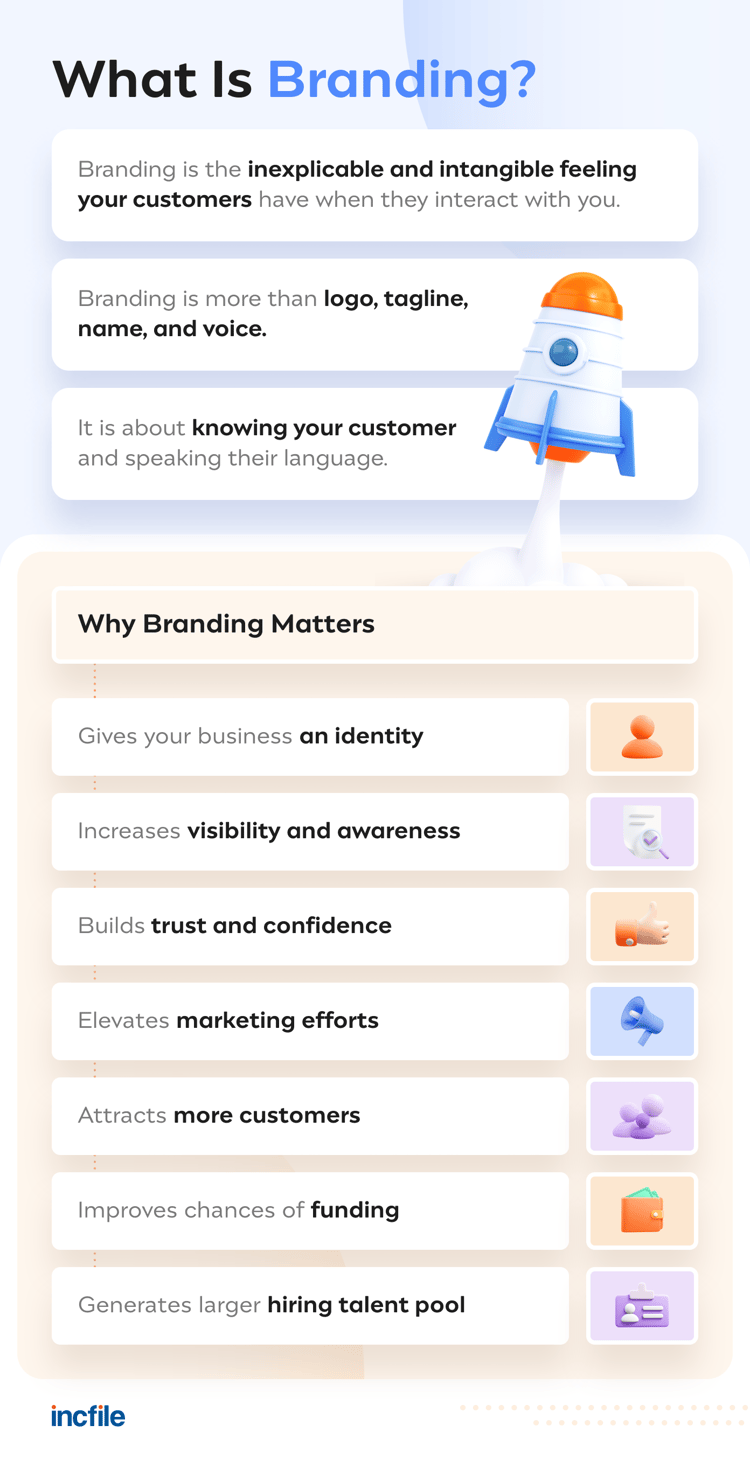

How do you stand out among the 33 million small businesses in the U.S.? You need to be unique. But a unique brand isn't just about a name, catchphrase, or logo. It's about the way your audience perceives and feels about your business.
Follow our nine-step guide on how to brand your business — all without blowing your budget.

1. Pick a Catchy Business Name
Naming your business is one of the first big decisions you'll make — one that impacts your logo, tagline, website domain, and social media handles.
Creative strategies to come up with a business name include:
- Performing a word dump
- Playing on famous idioms or movie titles
- Combining words
- Using synonyms
Our business naming guide and Business Name Generator Tool can aid you in finding a name that is unique, easy to spell and pronounce, and readily available.
Once you have narrowed down the name, it's a good idea to perform a domain name search to make sure you can use it on your website. This will help create consistent branding. For extra branding strength, check to see if your desired name is available on all the social media platforms you plan to use.
2. Write Your Company Mission Statement
Spend time developing a mission statement to give yourself a framework and voice for all operations, from product development to customer support. This should be a short, to-the-point mantra for your company to adhere to.
Here are some examples of company mission statements:
IKEA: "To create a better everyday life for the many people."
TED: "Spread Ideas"
Tesla: "To accelerate the world’s transition to sustainable energy.”
Before creating a company mission statement, ask questions like:
- What's the driving force behind this business?
- Why does this business exist?
- What problem or challenge does this business solve?
3. Get to Know Your Audience
As companies continue to improve branding, consumers continue to raise their expectations. Personalized experiences from brands are important to 70% of consumers, and this number is up from 67% in 2019. However, you can't personalize your branding until you have a strong understanding of your customers.
Here are some ways to better understand your audience:
- Study Existing Customer Data: If you've already begun business, round up your existing customer data and identify any similarities in demographics, pain points, and preferences between your audience members.
- Create Buyer Personas: A buyer persona represents your ideal customer. It helps align your company's product, content, and brand. Buyer personas include information on demographics, challenges, goals, and motivation. HubSpot has a buyer persona template that can get you started.
- Conduct Interviews: Talk to a test group and ask them which brands they purchase from and why. Question them about their needs and likes, and ask which brands they admire or follow. The test group can consist of family, friends, and random volunteers.
- Perform Market Research: Uncover customer trends, buying habits, and opportunities by conducting market research. Industry forums, Facebook groups, Q&A websites like Quora, and relevant social media sites are excellent places to start. You can also Google your product and identify your competitors, then examine the demographic of their customer base.
4. Build a Value Proposition
How can you brand your business to make it stand out from the rest? Build a value proposition to tell your brand's story. A value proposition shouldn't just highlight product features, components, and benefits; it should offer actual value to your customer's life.
Check out these vision statements to spur your creativity:
Meta: "To give people the power to build community and bring the world closer together."
Southwest Airlines: "To be the world's most loved, most efficient, and most profitable airlines."
Nike: "To bring inspiration and innovation to every athlete in the world.”
HubSpot has value proposition templates that will get you thinking about what makes your brand special and help you convey that message.
5. Consider Your Design Assets
A brand's design assets include logos, colors, fonts, slogans, mascots, and packaging. These elements make it easy to identify your business and help it stand out.
Here are some design assets to consider:
Color
Certain colors and combinations are more recognizable to customers and can positively impact your business. You want to choose a color that suits your brand story and appeals to your audience.
The majority of the top brands use the following colors:
|
Color
|
% of Top 100 Companies That Use It
|
What the Color Signifies
|
|
Blue
|
33%
|
Trust, Dependability, Confidence
|
|
Red
|
29%
|
Passion, Strength, Excitement, Drive to Action
|
|
Black/
Grayscale
|
28%
|
Class, Timelessness, Sophistication
|
|
Yellow
|
13%
|
Happiness, Positivity, Fresh Starts
|
Source
Logo
Logos are your business's primary calling card — something visual that can go on your website, marketing materials, packaging, videos, and social media profiles. You can work with a designer or use a free website like Looka.com, Logo.com, or Canva to create one. Remember to test how your brand colors pair with your logo.
You can also include multiple logo variations (different sizes or configurations) for various marketing materials. For example, a smaller-sized logo would work better as a packaging sticker.
Slogan
"The Happiest Place on Earth" and "Imagination at Work" are both famous slogans that aren't just recognizable — they tell us exactly what Disney and General Electric stand for.
Slogans are short phrases that hold serious branding power. And when they're combined with the right logo and colors, they can turn your company into a winner.
Try Shopify's Slogan Maker to get your ideas flowing. You can even chop up your mission statement to get started. Create rhymes, brainstorm slogan ideas, and don't stop until you find something that works.
6. Create Your Website and Social Channels
In 2021, 230 million Americans shopped online and this number is only expected to increase. You need to have a website and a social media presence to build a brand that stands out in today's market.
Luckily, you don't need to be a coding expert to create a website. Website builders like Wix and Squarequare can help you get online faster than ever.
But even after you build your website, remember that 75% of users never go beyond the first page of search results. If you want your website to have the maximum reach, you need to optimize for SEO, which stands for search engine optimization. Here are some SEO tips to get you started:
Social media allows you to create business accounts and build a brand presence within minutes. Customer research will help you identify which social media channel is preferred by your audience. Pictures, Instagram Reels or TikToks, and long-form videos are the top content choices for social media. You can invest in social media automation tools to help you stay on top of this.
7. Plan for Consistent Messaging
Having a consistent message has increased revenue by 23% for brands. To tell a cohesive story, you must have consistent messaging at every customer touch point.
A brand style guide will help you manage your brand consistency. Your style guide should include usage rules on the following:
- Logo: Provide directions on when and where your logo and each iteration (primary color, complementary colors, and size) should be used. Specify formatting options for each social channel.
- Typography: Include rules for font names and sizes. Address what needs to be capitalized or spelled out.
- Voice: Emphasize the tone used for blogs, messages, and other content.
- Image: Have guidelines on how to source images and give credit. Again, mention the appropriate sizing and proportions for each channel.
8. Prioritize Your Customers
How can you show customers they're your number one priority? You must focus on customer experience and seek feedback from your buyers. Use automated chatbots or Whatsapp for Business to make it easier for customers to connect with you and provide testimonials.
Delight customers with something small like handwritten thank-you notes or a free sample with their first purchase. It also pays off to reward customer loyalty. If they post about your brand, respond and re-post what they've written. If a customer sends a referral, offer them a discount in exchange. Prioritizing your customers through their entire journey can turn them into brand advocates.
9. Form Strategic Partnerships
Strategic partnerships can help you raise your brand awareness even if you have a tight budget. They can also help you quickly establish trust with new customers.
Look for other small businesses with consumers who overlap or compliments yours. To find them, do a Google My Business search or explore Facebook Marketplace. Once connected, you can both cross-promote products to new clients while building value for older ones.
To ensure you're partnering with the right brand, ask these questions:
- Does this brand target a similar or parallel audience group?
- What is the brand's reputation?
- Does the brand follow through on its story and purpose?
You can also tap into the power of influencer marketing by partnering with social media influencers. Research hashtags, competitors' followers, and social media groups to identify influencers who best suit your brand's story.
Benefits of Strong Branding
Consistent, robust branding gives you an identity and ensures your customers always pick you over the competition.
Here's what else solid branding can do for your small business.
Increase Brand Recognition
Your company's logo, colors, or tagline can make your brand recognizable and get customers to say, "Yes, I know them!" The more often customers are able to identify your brand, the more likely they are to buy from you.
Build Customer Loyalty
A consistent brand can build trust and credibility with your audience and make your brand 3.5 times more visible to your audience, according to Marq's 2021 State of Brand Consistency Report. Customer loyalty is a crucial deciding factor in your customers' purchase decisions.

Improve Marketing Efforts and Return on Investment
Unified branding elevates your marketing efforts and generates higher returns. It also reduces the time you spend figuring out "new" ways to reach out to customers, allowing you to focus on delivering them the ideal experience.
Increase Chances of Funding
Branding is a great way to get your business in the eyes of investors, providing you with an influx of capital. Investors are constantly looking for companies with solid brand recognition and loyalty. For them, these brands present the greatest potential.
Make It Easier to Launch New Products
Once you have a consistent and recognizable brand, it's easier for you to grow your business and test out new products. Customers are more receptive to trying new products or services when they're familiar with your brand and trust your company.
Provide a Larger Talent Pool
People are eager to work for reliable, established brands. When you're ready to grow, your well-known brand can give you more options when it comes to finding talented, hardworking employees.
How Do I Brand My Business on a Tiny Budget?
Branding doesn't require a big budget — it requires time and effort. The idea is to build a lasting connection with your core audience group, and you can use a variety of strategies to do so. Almost all of our tips above on how to brand your business require little money.
That said, word-of-mouth marketing is one of the best, low-cost methods to drive new revenue for small businesses. Every time your brand succeeds in resonating or identifying with your audience group, you set yourself up for more customers who are more likely to become your ambassadors.
Don't shy away from making use of free branding tools like:
5 Companies Nailing the Branding Game
How do you find branding ideas? Research competitors and other industry pioneers to create your own unique brand experience. We've rounded up five powerhouse companies winning the branding game to help you get started:
- ASOS: The brand's mission statement is direct: "Our mission is to become the world’s number-one destination for fashion-loving 20-somethings." As such, their colorful content, product designs, and mobile-first approach align with their young audience seamlessly.
- Death Wish Coffee: This small business has a morbid (yet funny) name that suits its tagline, "The World's Strongest Coffee," setting it far apart from the competition. The brand knows its customer — someone who's after the caffeine kick.
- Made With Local: Homemade, wholesome, and nutritious. That's what Made with Local is all about, and that's exactly what's depicted through its mission, logo, business name, and packaging.
- Pop Fit Clothing: Pop Fit's range of athletic wear may seem all about bright colors and patterns, but the brand's mission highlights the company's commitment to promoting body positivity and inclusivity. Their product range includes all sizes, and it's made for everyBODY. The brand's mission is reflected in ads that feature real, untouched models.
- LUSH: LUSH is all about making "effective products from fresh fruits and vegetables." The company's messaging is conveyed through its in-store product displays, where raw soaps and shampoos are packed right in front of your eyes. The packaging even encourages recycling, ensuring the brand's mission is on full display.
Long-Term Branding Tips
Remember that your brand will evolve as your business is exposed to more customers, making it necessary to audit your branding strategy every few years. You might discover that some brand assets are outdated or underused, and new tools will always come along to help.
With the right effort, you can create a strong brand ready to compete with your top competitors. Incfile's Platinum package provides all the support you need to start your business and build your branding strategy. We'll help you find a business name, provide a free domain name and business email address, legally form your business, and more.
